Dammed, Displaced and Democratized
Part five in a series of stories from my road trip in Thailand, participating in a study tour hosted by Pun Pun farms, to visit local examples of sustainable living in the Northeast and in Chiengmai.
Self Reliance and the Earthen Building Movement
As founder of the earthen building movement in Thailand, our tour leader Jo Jandai had contributed much to the concept of living sustainably. As a farm boy he grew up believing, as others did, that his future prospects lay in getting more education and finding work in the city. His epiphany came after seven years of living in Bangkok working everyday and barely making ends meet. What kind of a life is this? he asked himself. He was not an engine. Jo then returned to his family farm with the intention of becoming self-reliant. This was a man after my own heart for I, too, thought self-reliance was preferable to dependence on money.
For me this meant being able to cook, garden, sew my own clothes and fix the house I was living in. I even enrolled in a two-semester construction technology class to learn carpentry, electricity, sheet rock installation, roofing and plumbing. Once I saw what was beneath the sheet rock, I realized that our homes were really just a clever illusion of comfort—a stage set of thin materials propped up with sticks. This badly insulated, leaky box then had to be heated using fossil fuels piped over long distances or air-conditioned with electric power at peak hours. Building materials were manufactured and trucked from far away while the building industry itself was one of the largest generators of garbage. And it was all so unnecessarily expensive. People were made slaves to their mortgage.
I was already enamored of straw bale buildings, which used local agricultural waste straw to create massive walls that would moderate interior temperatures. A few years later, I explored my interest in natural building by taking a cob building workshop, a close cousin to adobe. I collected books on tiny houses and lulled myself to sleep engineering in my mind structures made from available materials.
Jo had a head start building a real house on his family farm. It was made of bamboo, a readily available building material. Then, on a trip to the US, Jo happened to visit a pueblo in New Mexico and was struck by the cool temperatures inside the building relative to the hot dry climate outside. His home in Isaan had a similar climate. After studying the pueblo ruins and seeing how the adobe bricks were put together, he came back to his farm and began experimenting with building his own adobe house using a wood frame to make bricks. Transporting wood poles on his bicycle for the roof, he had a house built in three months, working only two hours a day. "This is so easy," he said to himself, marveling at this discovery of self-reliance. Better yet his house was virtually free while a concrete house, which is what his neighbors aspired to build, cost $15,000 baht. His neighbors came to watch and laugh at this folly of this crazy man building a house from mud.
The Principle of Easy
I too, was struck by how easy it was. After a week at my cob workshop pressing the mud and straw mixture together with my thumbs we only had a wall that was thigh high. With adobe bricks a house could be finished in a few days. It didn't seem right, yet it still had the same insulating qualities as cob or straw bale, was made from the surrounding earth and could be finished with sculptured decorations just like cob.
Making things easy, I realized, was the mantra of being Thai. All this time I had felt that this was our downfall—that the reason the Chinese did so well in business was because they were willing to work harder than the Thais. Challenged by the Chinese heritage of my Bangkok family, I had felt delinquent claiming to be Thai as if I were announcing that I had no plans to succeed. My American peers compounded this feeling by working hard to achieve "goals". I fended off such expectations and firmly claimed to be a Slacker. Secretly, I worked quite diligently on the projects I was interested in—hobbies they were called by others.
Jo told us, he had so much free time after learning to build his own house and grow his food organically that he started a children's group, a singles group and a library. He also had time to reflect and enjoy the beauty in life. He was not, however, considered a catch by the local village girls.
"No Thai girl would date me because I don't have a motorcycle," he said smiling. He didn't say it, but we could see that this was why he ended up dating farang girls and marrying Peggy, now sitting next to him as he told his story the first day of our study trip. Peggy had come to Thailand to work with the urban poor, but then decided to back up a bit and work with the rural poor before they ended up in the city.
"But how did you end up going to New Mexico?" I asked him in private. Poor Thai farm boys do not usually travel so far from home just to see the sites.
"My ex-wife wanted me to go because she live there," he explained. Ah yes, I nodded, "so another door opens". I did not want to pry further after the motivations of this ex-wife though I was interested in every farang's story who chose to spend time in Thailand. And besides it would be poor form with Peggy just a few yards away.
Jo's fame as an innovative builder came about in a similar circuitous way. First his neighbors had to experience the earth building for themselves. This they would do through another enterprise of self-reliance on Jo's part. After learning to make his own soap and shampoo, he organized a co-op to make and sell these products. This led to the need for a store in which to sell them in the village. Jo built the store and when customers came inside to shop they too experienced how cool it was inside the little earthen building. Soon other families ventured to make their own houses out of mud.
A Thai nun writing for a magazine discovered the adobe houses and published a story about Jo and his Baan Din, or "houses of earth". He became sought after by the public to help others build their houses. Over the course of three years he traveled all over Thailand helping to build some 300 houses for free.
Dammed, Displaced and Democratized
Half way through our two-week tour we packed our bags, loaded them onto the truck and said good-bye to Jo's family farm. Jo, Peggy and their little boy Tahn came with us to escort us to their northern home in the hills of Chiengmai, but first we would stop at a mountain community that had formed in the wake of a ten-year protest.
I had read about the protest and had been intrigued by this band of villagers that had set up camp on the lawn of the elegant parliament building in Bangkok. The villagers had lost their homes due to a large dam project (funded by the World Bank) flooding their land. The protest attracted others including displaced slum occupants, workers harmed in the workplace, prostitutes, those protesting encroachment on the forests and a large group called The Assembly of the Poor. For ten years, on and off, the groups protested until finally Thaksin, who had become Prime Minister at that time, undermined the Assembly of the Poor by giving the key leaders well paid jobs on various government committees. To those displaced by the dam he offered a piece of land that he then said they had to buy with a loan of 4 million baht from the government. Already in debt from so many years of protest, the villagers accepted the land hoping the government wouldn't come asking for the money.
The resulting settlement was by far the most famous site of earthen houses we would visit, boasting its own road sign. Both Jo and Janell, also traveling with us, had been part of the international group that had helped the villagers build their own houses, install solar panels, build a school and another beautiful community building. Located high atop a mountain ridge, the open land of tall grass partly obscured the pink and yellow earth tones of the buildings. Mun Yeun, as it was called, had the air of a resort during the off-season. We pulled our bags off the roof of the truck and carried them to the schoolroom where we would later sleep elbow to elbow.
After a brief tour of the area, we assembled in the schoolhouse to hear what the three founding members of the village had to say. It soon became apparent that something was wrong with this picture. Of the 35 families that agreed to buy the land from the government, only nine were actually able to move here and only three remained. When we asked why, the men told us the families had gone to find work to pay off their debts.
So this is what democratic protest gets you, I pondered to myself, the right to protest, but not the right to be?
My fellow travelers offered suggestions, wanting to solve the problems facing the three founders. Martin, our practical minded chicken farmer, asked if they could grow cash crops. They had not been able to, they told us, but if they did they feared that the government would start asking them to pay off the 4 million baht debt.
Someone else asked if the King could step in. We knew the king to be a just man and an advocate of self-sufficiency, but no he had no such power to help them. He was only a figurehead.
"What about the government that supports self-sufficiency," asked Jen referring to the talk we had heard at the Santi Asoke center about how the government banks had wanted farmers to take the training in self-sufficiency before taking out a loan.
"No government wants self-sufficiency" I said bitterly. Jo agreed. It was all a manipulation to get poor people to work for rich people. The earlier promotion of self-sufficiency, after the financial collapse, had been an act of self-preservation to keep the banking system from going under, I realized. I was filled with despair that no one wanted these villagers where they were; they were just in the way of progress.
"Maybe they are a tourist attraction for travelers to witness the impact of globalization," I said quietly.
Jo did not translate this sentiment, just vocalized an agreement. Janell, who was sitting next to me, did not offer a sassy comeback. She was silent, possibly absorbed in her own thoughts of the project she had directed. Except for a few houses and a carport, these beautiful buildings were now largely abandoned.
Would people choose industrial progress if they knew the cost? How well I understood the need for massive dams to provide electricity to an industrialized city eager to power its consumer lifestyle. The dam in question would provide enough power for one shopping mall in Bangkok. Back home in the States ever-expanding server farms (computers supporting the Internet), were being built as close to dams as possible for the cheap electricity rates of clean hydropower. There was no end to our need for more power once started.
The villagers had been told the dam would help them irrigate their land, but that obviously was not the case as the plan was to flood their land altogether. The men implied that, had they known what was to come, they would have protested sooner.
"Ten years was a long time to protest. What kept you going?" I asked. This seemed to strike them as a silly question and they laughed at the mention of the ten years.
"There were a lot of issues needing to be discussed," one said simply.
I was trying to find the point to it all—the point of democracy and progress. This land was not theirs, it could be taken away for development into a resort for city people, the government wanted money and the land needed to be maintained to protect it from fire, but there weren't enough people to keep the fire breaks clear. The villagers had not been in agreement about the communal vision necessary to protect themselves from larger economic forces. Many had wanted to subdivide the land and go their own way with it, sell it even. I was frustrated by this failed vision and asked why they continued with it.
"They are just trying to survive," Jo explained. My thoughts were arrested midstream as I realized how bourgeois was my need for meaning and purpose. I, who could go home after a day of protest, had the luxury of righteous principle. Surviving meant continuing to try whatever might work. At the moment the three men were planting trees. They had been a forest people and even though they did not know the trees in the area, they knew how to cultivate a forest. The government officials came by, saw the plantings and did not ask for money. They just told the villagers to keep records of what they were planting. This was seen as hopeful. The villagers knew that the government were, now, wanting to grow back the forest, which would justify leaving them be. Meanwhile the protests had caused so much controversy that none of the other proposed dams were being built.
Dimly I began to understand that perhaps there was an optimum vision here. We learned more about their projects to reforest; how they were teaching their neighbors the value of leaving the land undeveloped. They were offering the investment of a cow in a sort of community supported beef supply that gave back in manure and offspring. Montaine asked what chore we could do to help them out. Thus our group spent the next morning raking manure in the cow pen into a big pile.
As we packed up to leave, a group sat down near me to sign the large guest book. Erin our Australian student was chosen to scribe since she had the best handwriting.
"What shall we write?" Sasha, our American student asked.
"Good luck," I suggested cynically, "We landless server farmers promise we won't build any more dams." Needless to say this was not considered a serious suggestion, but they acknowledged my declaration of guilt with respectful silence.
"What about this?" said Irena eagerly, "May the forest give back a hundred fold what you put into it."
"Oh that is so nice," I said sincerely, then laughed at the whiff of sarcasm I barely managed to pull back. Ah youthful optimism. The others agreed and Erin wrote it down.
Labels: democracy, globalization, Isaan, protest, Thailand, travel
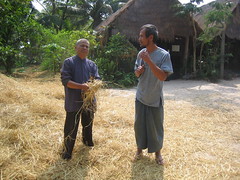
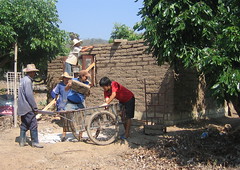
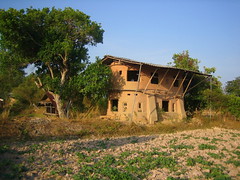
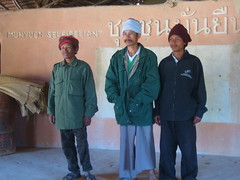
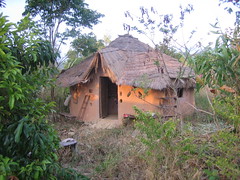
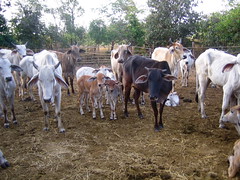




0 Comments:
Post a Comment
<< Home